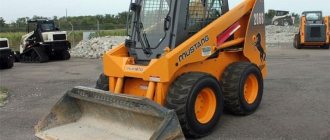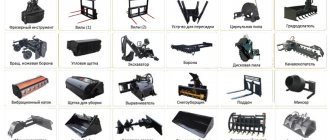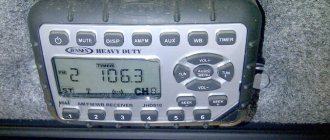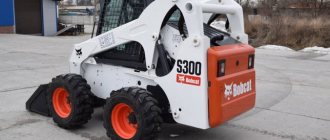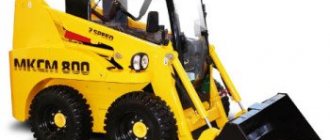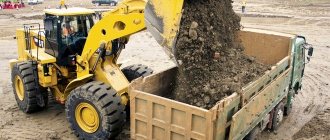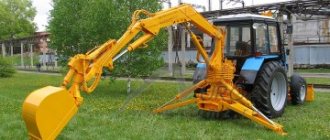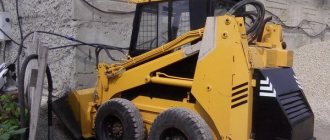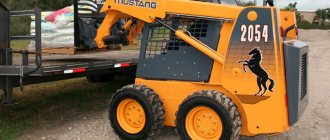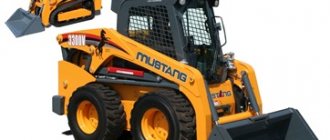Mustang 2086 is a mini loader with compact dimensions and high performance. This device is in demand primarily in small and hard-to-reach areas. This model has earned a large number of positive reviews from consumers who need an inexpensive and high-quality device for a variety of tasks. The Mustang 2086 model received balanced characteristics and proven technical solutions. The developers did not introduce any innovative components into the design of the product, as this would have a negative impact on the cost of the machine. The result is a durable loader with excellent maintainability and good loading capabilities. This article also presents its characteristics, cost and operating features.
Purpose
Mustang 2086 is a productive vehicle that can cope with loading and moving cargo over long distances. The machine is actively used in ports and airports, rural areas, shopping areas and industrial areas. So, depending on the installed equipment, the Mustang is designed for handling cargo, as well as cleaning areas, including cleaning sidewalks and roadways from dust, snow and debris. Of course, the equipment is also intended for pothole repair of roads - for example, after the end of the winter season. In agriculture, this loading device is widely used in earth-moving operations - including, it is capable of mowing large volumes of vegetation - in particular grass. Support for a wide range of options, as well as high load capacity and operating comfort, make the Mustang 2086 a universal mini-loader that is designed for a wide range of tasks. It’s just worth noting the car’s excellent off-road capabilities – largely thanks to the tracks.
Attachments
- Tracks on wheels are a very useful device for the Mustang 2086 wheel loader. Thanks to them, maneuverability on loose soil is significantly increased. Installing the tracks does not take much time. Let's pay attention to several types of cap caterpillars, which, depending on the modification, can be used for working in snow, on ice, on construction sites, as well as sites with wet clay.
- Solid wheels are a worthy replacement for classic tires, which are included in the basic package of the product. In fact, what we have in front of us are seemingly standard wheels, with a regular metal disk and a rubber tire. The main feature is a unique deep tread, as well as increased resistance to damage and improved wear resistance. It is almost impossible to puncture thick rubber. It should also be noted that the wheels are heavier, which has a beneficial effect on increasing the load capacity.
- Attachable excavator - gives the Mustang mini-loader the capabilities of a full-fledged excavator. The device is equipped with hydraulic rotation, and the mounting method is similar to that used in a conventional bucket. The capabilities of a mini loader-excavator are no different from a full-fledged excavator.
- The bucket attachment is the most common skid steer attachment designed for raking, loading and moving construction and bulk materials. It is used in construction and public utilities - for example, when cleaning areas. The bucket volume reaches within 0.6 cubic meters. m. This option comes with the loader, but there are several types of buckets on the market. Their functions are limited not only to raking and cleaning, but also to moving soil, sand or debris.
- The jaw bucket is a variation of the classic bucket. This option includes two “jaws” that lock together. Thus, the front part of the bucket acts as a loading bucket, designed for loading earth, sand, garbage and other bulk materials, as well as foliage. The rear part, in turn, works on the principle of a blade. If necessary, the front and rear parts form a grip that holds the load so that it does not fall out. These buckets can be equipped with an edge or replaceable teeth.
- Concrete mixing bucket is an alternative to mixer machines. Essentially, we have a mobile concrete mixing machine that will prepare a high-quality cement mixture within 10 minutes. Concrete material is loaded into such a bucket manually and unloaded by tipping it through the lower unloading hatch. At the same time, for ease of unloading, you can attach a drain hose. The bucket is supplied with a protective grill.
- Pallet forks are a device for loading and unloading cargo containers, which are usually placed on pallets. In fact, thanks to them, the machine turns into a full-fledged forklift, designed specifically for transporting goods with a total weight of up to 2500 kg. Pallet forks have a tip-over safety feature, as well as increased lift height and fork height adjustment.
- A brush is a utility device for cleaning walkways, alleys and sidewalks from debris, leaves, dust and other loose debris. The brush rotates at a fast speed, allowing you to instantly sweep away all the dust from the sidewalks. The brush can rotate up to 25 degrees, depending on the selected settings.
- Rotary mower – equipment for work in agriculture and landscaping. For example, with the help of a rotary mower you can trim lawns, monitor the condition of private territory, quickly prepare hay for the winter season, effectively process overgrown grass and weeds, and also work on uneven ground surfaces.
- A stump remover is an effective device with sharp teeth that penetrate the ground to a depth of 0.5 meters. In this case, the stumps are removed along with the roots, the remaining underground part gradually dries out, and as a result, a smooth and treated surface is formed. In addition, it should be noted that a stump remover copes with its task better than a stump grinder.
- Trash digger is a mounted option for construction and repair work. It is a soil cutter that can significantly expand the functionality of the machine. This equipment is designed for digging trenches to a depth of up to 1200 mm, as well as a width of up to 200 mm for utilities. The trencher is especially common in agriculture and construction. Controlled from the operator's cabin using a special switch.
- The cultivator is one of the most popular attachments for agriculture. Carries out preparatory work related to planting lawn grass and other types of plants. The cultivator is capable of working at a depth of up to 155 mm.
Device Features
- Convenient work in cramped conditions due to high maneuverability and compact dimensions. We note the relatively small turning radius, as well as the wide glass area of the cabin. In addition, we will also add here the thermal insulation materials that cover the body panels of mini loaders. Thanks to the insulation from, it was possible to reduce noise and vibration compared to other diesel forklifts. The cabin is quite quiet, and nothing distracts from work. This makes the driver less tired and able to work longer. In addition, we note the high level of ergonomics of instruments and switches, which are located almost at hand, and you don’t have to reach for them. If necessary, you can configure the digital color display so that it displays information about the status of working units and assemblies, the degree of load or overload of the attachment. The climate in the cabin is controlled by an effective ventilation and heating system, as well as a built-in filtration system that prevents dusty air from getting inside. The seat and steering column can be adjusted at your discretion, and thus customized to suit you.
- Compared to electric forklifts, a diesel machine does not need to be refueled for several hours, or look for a suitable place to charge or change batteries, especially during multi-shift operation. With this, diesel cars have everything at the highest level - the refueling process does not take much time.
- Relatively low cost compared to competitors, and especially electric cars.
- High practicality and longer length of cargo transportation.
Disadvantages compared to electric forklifts
- Mediocre environmental performance, despite the use of catalytic converters and filters.
- Increased noise and vibration, despite the additional layer of sound insulation in the engine compartment and interior.
- The low quality of diesel fuel in Russia forces users to buy double fuel filters to reduce the harmful effects of fuel on internal combustion engine components.
- The need for regular maintenance, timely replacement of filters, oils and other consumables.
Perhaps the first thing you notice is that the hydraulic cylinder rods are made of nitro steel instead of the usual, mirror-shiny ones. Not long ago we had to test a Gehl loader of the same class, made in Germany, and this feature, associated with surface hardening of the hydraulic cylinder rods, was the most noticeable external detail. As we learned later, these loaders are produced in the USA and Germany by the same manufacturer under different brands.
To begin with, we were asked to observe the forklift in action with an experienced operator at its levers. Here the machine made the most favorable impression in some operations - leveling the ground or loading sand into a bucket and pouring it out a little further away. Well, it's time to take a closer look at the equipment of the cabin and the entire loader.
The process of entering the cabin is convenient, thanks to special support plates located on the bucket and a wide anti-slip strip pasted in front of the cabin, as well as several handrails outside and inside the cabin. Their arrangement is well thought out, as a result of which you can sit in the chair without unnecessary effort. The sprung seat can be adjusted fore and aft, tilt and for the weight of the driver. Control devices, switches and warning lamps are located on the A-pillars, which allows you to keep your surroundings in sight when looking at the instruments and switching.
The most notable feature of the control mechanisms are the levers, or rather a hybrid of levers and joysticks. As a result of this connection, it is possible to place additional buttons and switches in the upper, “joystick” part of the levers. There are not very many of them - only the most necessary things, which usually have to be used immediately during the work process. These buttons and switches control the following functions: control of additional hydraulic equipment, sound signal, increased speed, constant speed of movement and maintaining a given bucket position while driving (some of these options were installed on the test machine). The levers are used to control the movements of the loader itself, and 2 floor pedals are used to control the movements of the boom and bucket. One of them controls the up and down movements of the boom, while the other is responsible for turning the bucket.
On the right front pillar of the cab there is an engine speed controller with three fixed modes: slow, medium and accelerated. In order to begin movement and work after starting the engine, it is necessary to move the safety bar to the lower position.
The cabin meets the requirements for protection against rollovers and falling objects on the roof ROPS/FOPS - Level II. There are two halogen lamps on the front and rear of the cab - for working in low light conditions or at night. The cab also has loading eyes that allow this compact loader to be easily loaded into a truck bed.
To ventilate the cabin, you can use two wide sliding side flaps. It is also possible to use the ventilation and heating system, the nozzles of which are located in several places in the cabin. If desired, you can also order air conditioning. Also among the optional equipment are controls with two small joysticks, an engine preheater, the Multi-Tach system (allows you to change attachments using hydraulic grips without leaving the cab), and the Hydraglide shock smoothing system.
The loader engine is a Japanese Yanmar diesel, with a volume of 3,319 cm3 and a power of 84 hp. Maximum torque of 301 Nm is achieved at 1,850 rpm. By opening the rear and top covers of the engine compartment, you can gain convenient access to the filters. To carry out service work on the transmission or hydraulic system, the cab can be raised without much difficulty.
The basic 0.52 m3 bucket allows you to lift an impressive 1,179 kg of cargo (with the use of an additional counterweight, this figure can be increased to 1,320 kg). A modern hydraulic system controlled by electronics, which increases service intervals, allows you to handle heavy loads. A pressure reducing valve protects the hydraulic system from excessive loads. Optional high-performance hydraulics, designated High Flow, are designed for high-performance hydraulic attachments (for example, this option is popular among Russian road construction organizations that use drum cold milling machines and circular saws for road repairs). To connect additional hydraulic equipment, appropriate connectors are installed in front of the loader cabin.
The most pleasant experience was testing this mini loader in action. Having started the engine and throwing the safety bar over myself, I begin to move and expect to feel the usual jerk, but instead the car begins to move very smoothly, and only by tilting both levers considerably away from itself does it begin to move quickly. The reason for such smooth and stable movement is partly due to the large range of movement of the long control arms. The control settings are simply excellent. The machine can be controlled, literally, with pinpoint precision. The feeling is that the loader does not move following the movement of the hand and lever, but follows directly the operator’s thoughts. Having decided to check whether such smoothness is associated with soft soil in the form of compacted sand, I also try movements with an arrow and a bucket, the influence of the soil on which is microscopic. The result was the same. Using a “twist” located right in front of my eyes, which controls engine speed and hydraulic performance, I tried out the medium and slow modes.
If in medium mode the smooth operation of the loader is simply pleasant, then in slow mode it is admirable. The movement of the car is graceful, as if it is waltzing to classical music. Undoubtedly, in terms of the quality of control settings, coupled with all other parameters, the Mustang 2086 is among the leaders in this segment. Of all the mini-loaders we tested, perhaps only two or three devices gave so many positive emotions.
Summarizing the results of the test, we can confidently say that if you need to choose a high-quality and reliable mini-assistant, you should take a closer look at a model such as the Mustang 2086. This loader will not cause fatigue, thanks to the excellent combination of smoothness and speed of work. And the consonance of the name with the famous sports car is not a grin here, but only characterizes the pleasure of driving that is inherent in this construction machine.
Operating weight – 3,565 kg Bucket volume – 0.52 m3 Nominal lifting capacity – 1,179 kg (1,320 kg with counterweight) Engine designation – Yanmar 4TNV98T Engine type – in-line 4-cylinder liquid-cooled turbocharged diesel Displacement – 3,319 cm3 Rated power – 84 hp (63 kW) / 2,500 rpm Maximum torque - 301 Nm / 1,850 rpm Environmental standard - TIER III Drive - 4-wheel drive Maximum speed: 12.4 km/h (18 km/h - High Flow) Steering – skid steer system Turning radius (according to bucket angle) – 2,192 mm Wheelbase – 1,229 mm Track – 1,702 mm Ground clearance – 193 mm Rear overhang angle – 21° Length of loader with bucket – 3,526 mm Width (at bucket) – 1,709 mm Total cabin height – 2,057 mm Height with bucket raised – 4,064 mm Maximum hydraulic system pressure – 20.7 MPa (207 bar) Hydraulic capacity – 81 l/min (140 l/min – High Flow) Bucket width – 1,778 mm Maximum unloading height – 2,413 mm Bucket reach at maximum unloading height – 711 mm Maximum unloading angle – 40° Tipping load – 2,358 kg Maximum breakout force: when lifting the boom – 28 kN (2,850 kgf) at bucket rotation – 25.8 kN (2,630 kgf) Average hourly fuel consumption – 13.6 l/h Fuel tank capacity – 91 l Hydraulic system tank volume – 61 l Battery – 12 V; Ah (950 CCA) Tires (front and rear): 10.00x16.5
Specifications
- Load capacity – 1315 kg (with counterweight)
- Total weight/tipping load – 3583/2358 kg
- Engine name – Yanmar 4TNV98T
- Environmental standard – Tier III
- Engine type – diesel
- Power/rotation speed – 84 hp. s./2500 rpm
- Speed – 20 km/h (maximum)
- Ground clearance/wheelbase volume – 203/1229 mm
- Loader dimensions, mm: Length – 3563, Width – 1753, Height – 2057
- Height of the bucket suspension point/work bucket edge reach – 3124/894 mm
- Fuel tank capacity – 90 liters
- Unloading height/bucket lifting height – 2354/4275 mm
- Tire parameters – 12.00x16.5 HD
- Working body – bucket
- The width of the cutting edge of the bucket is 1880 mm.
Mini loader MUSTANG 2086 (USA)
Mini loader MUSTANG 2086 (USA) with a nominal load capacity of 1179 kg, and a breaking force of 2639 kg. supplied to the market with a Yanmar diesel engine (Japan) - 84 hp. (3.3 l.) - guaranteeing optimal performance in any area.
The stove and glazing come in a basic version, air conditioning is installed at the request of the customer.
The MUSTANG 2086 cab lifts up easily and effortlessly, providing access for servicing hydraulic pumps.
This model has 2 control options: double levers with pedals and joystick control. These controllers combine hydraulic control, horn control and additional equipment such as two-speed driving, driving control and heavy-duty hydraulic pump control.
The safety system disables lift, tilt, drive and hydraulic functions when the driver raises the armrest, leaves the seat, or turns off the ignition.
Special 4 eyes in the front and rear of the loader allow you to safely transport the machine by lifting it with a truck crane. The MUSTANG 2086 model offers 2 hydraulic options: a standard hydraulic system and an increased power hydraulic system.
“High flow” machines are very popular among Russian road construction organizations that carry out pothole repairs and use drum “cold” cutters and circular saws to perform various road restoration tasks.
| A. Max. raised bucket height | 4275 mm |
| B. Max. bucket hinge height when unloading | 3124 mm |
| C. Cabin height | 2057 mm |
| D. Ground clearance (between wheels) | 203 mm |
| E. Length with bucket | 3563 mm |
| F. Length without bucket | 2687 mm |
| G. Wheelbase | 1229 mm |
| H. Unloading area | 894 mm |
| I. Horizontal lift-off angle of the bucket | 28° |
| J. Bucket tipping angle | 37° |
| K. Width on standard wheels | 12.00x16.5=1753mm |
| L. Standard bucket width | 1880 mm |
| M. Engine compartment turning radius | 1679 mm |
| N. Turning radius without bucket | 1372 mm |
| O. Turning radius with bucket | 2299 mm |
| P. Seat height | 1067 mm |
| Q. Bucket lift angle | 84° |
| R. Height of lowered bucket lip | 2354 mm |
| S. Rear overhang angle | 26° |
| Operating weight | 3583 kg |
| Tipping load | 2358/2630 kg*** |
| Rated load capacity | 1179/1315 kg*** |
| Breakout force | 2640 kg |
| Hydraulic pump supply | 82.3/139.6* l/min |
| Hydraulic pressure | 207/207* bar |
| Hydraulic tank | 60 l |
| Max. Travel speed | 0 - 12.4 km/h |
| 2-speed option | 0 - 19.8 mph |
| Standard bucket | 1880 mm/0.54 m3 |
| Universal bucket | 1880 mm/0.77 m3 |
| Light material bucket | 1880 mm/0.89 m3 |
| Engine | |
| Manufacturer | YANMAR (Japan) |
| Fuel | diesel |
| Power | 70.7 hp/52.7 kW |
| At rpm | 2500 |
| Number of cylinders/volume | 4/3300 cm3 |
| Fuel tank | 91 l |
| * Increased hydraulic power | |
| ***With counterweights |
